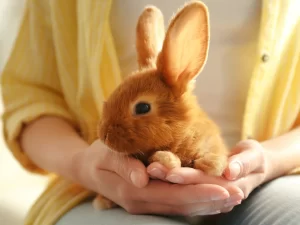Bringing a rabbit into your house may be a happy and fulfilling event. These gregarious, clever creatures are excellent companions, but they also need the right care and attention to be happy. This thorough guide will provide you with all the knowledge you need to get started with rabbit keeping the right way if you’re new to the hobby.
1. Recognizing Rabbit Needs:
Understanding a rabbit’s fundamental needs—housing, food, medical attention, socializing, and enrichment—is essential before taking one home. Because they are predatory animals by nature, rabbits want a cozy, secure space to live in.
2. Residing:
- Indoors or Outdoors: Rabbits can live either indoors or outdoors, but they fare best in settings that shield them from inclement weather, predators, and high temperatures. For safety and freedom, indoor bunnies require a roomy pen or a space that has been thoroughly checked for rabbits.
- The Ideal Enclosure: Make sure the cage, hutch, or pen you select is big enough to allow your rabbit to walk around and stretch out. A minimum of 12 square feet of living space plus a bigger area designated for exercise is the recommended size.
- Bedding and Litter: Place cozy bedding, like hay or paper goods, within the enclosure. Since rabbits can be trained to use a litter box, make sure it is stocked with safe litter.
3. Nutrition:
- Hay: The majority of a rabbit’s diet should consist of fresh hay since it gives their digestive systems the fiber they need. Hay from Timothy, oats, and brome are great options.
- Fresh Vegetables: Provide a range of veggies and leafy greens every day. Steer clear of cabbage and iceberg lettuce, since they may be harmful to your health.
- Pellets: Depending on your rabbit’s age and size, you should feed them high-quality pellets as a supplement to their food, but in moderation.
- Water: Whether it’s in a bowl or a sipper bottle, always make fresh, clean water available.
4. Medical Care:
- Frequent Check-ups: Arrange yearly veterinary checkups for examinations of overall health and, if necessary, vaccines. Look for a veterinarian who specializes in exotic pets or rabbits.
- Spaying/Neutering: Consider spaying or neutering your rabbit to lessen aggressiveness and avoid reproductive malignancies.
- Grooming: Especially for long-haired breeds, routine grooming is crucial. Brushing lowers the chance of hairballs and helps avoid matting.
5. Socialization as well as Enhancement:
- Social Animals: Rabbits are very gregarious and often get along well with a partner, as long as they are both neutered or spayed to prevent unwanted litters. Introduce rabbits cautiously and under close supervision.
- Play and Exploration: To keep your rabbit’s mind active and encourage natural behaviors like digging and gnawing, provide safe toys and enrichment activities. Allow them to explore an area that has been rabbit-proofed when they are not in their enclosure.
- Handling: To foster trust, handle your rabbit often and softly. Reluctantly picking them up can make rabbits feel uneasy since they are off the ground.
6. Selecting the Appropriate Rabbit:
Think about adopting a rabbit from a shelter or rescue organization when making your choice. The staff can assist in finding you a rabbit whose personality fits your lifestyle because many bunnies need loving homes. Think about things like temperament, size, and breed.
7. Conclusion:
Being a rabbit owner may be a very rewarding experience that gives you the ability to form a bond with a special and endearing animal. You can guarantee your rabbit has a happy and healthy life by giving it the right care, a balanced diet, routine veterinarian care, and lots of love and affection. Remember that commitment and education are essential for successful rabbit husbandry. Greetings from the amazing world of rabbits!
FAQs:
1. What should I know before raising a rabbit?
Before you get a rabbit, you should know that they require a lot of time, space, and resources. The lifespan of a rabbit is 8 to 12 years. They need daily socialization and exercise outside the cage, and their food should be based on hay, fresh vegetables, and a small amount of pellets. You can also adopt a rabbit from a shelter or rescue organization and give it a home.
2. Where should rabbits live?
Rabbits need a box or cage that is large enough to move around in. The cage should have enough space for a litter box, a place to eat, and a place to sleep. If your home is outdoors, make sure it is safe and protected from the elements. Rabbits do best when they can stay indoors and be part of a family.
3. Which food is best for rabbits?
To maintain good digestion and dental care, rabbits should eat 80% hay, such as timothy hay, orchard hay, or meadow hay. About 10–15% of your diet should consist of fresh vegetables and herbs. Green, leafy vegetables are the most important. High-fiber pellets can be given in small amounts. Always provide clean, fresh water.
4. How should I treat my rabbit and get it used to people?
Be careful when handling rabbits and support their back and lower legs so they feel safe. You can help your rabbit adapt to people by spending time with him every day and letting him explore areas inaccessible to rabbits while you watch. To build trust, give them treats and treat them gently. Most rabbits prefer to stay on the ground, so don’t hold them too much.
5. Does the rabbit need other rabbits?
Rabbits are social animals and thrive best when they have friends. However, adding rabbits should be done slowly and under close supervision to ensure they get along well. Neutering is recommended to deter unwanted puppies and prevent violent or territorial behavior.
6. How often should rabbits go to the vet?
Rabbits should visit the vet at least once a year for regular checkups. They also need to be repaired or neutralized to prevent reproductive cancer and behavioral problems. If you live in an area where certain diseases are common, vaccinations may be necessary.
7. Do rabbits know how to use the toilet?
Yes, rabbits are easy to train to use a litter box because they usually choose one or two places to go to the toilet. Place the litter box in the corner of the cage and in another area where they like to go outside the cage. Place hay in or near the litter box and use rabbit-safe litter. Rabbits like to eat while going to the toilet.


